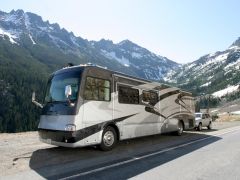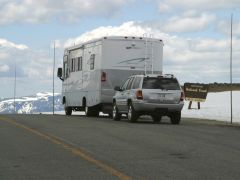-
Content Count
60 -
Joined
-
Last visited
-
Days Won
1
Content Type
Profiles
Forums
Blogs
Gallery
Everything posted by Cruzer
-
-
From the album: Cruzer
Our 2004 Allegro Bus in Washington State's North Cascades National Park, near Washington Pass.© © Mark Quasius
-
-
-
From the album: Cruzer
West Summit of the Beartooth Highway in our 2003 Suncruiser© © Mark Quasius
-

Gray Water Tank Odor Solved
Cruzer replied to zoso.chas@yahoo.com's topic in Water and Holding Tanks
That's a common issue. There probably is a P trap on that drain line but it's small and the top of the stand pipe is open to atmosphere so if the water that forms the seal in the trap isn't there, you will get that odor. If the coach stands for a while without running the washer-drier it can evaporate. Many times the water can get sucked out of the trap when dumping the gray tank. That depends on the vent for the gray tank. If the gray tank vent can't keep up with the masive outflow of water when draining the tank a vacuum will form in the tank and it will suck the water out of the trap. It all depends on your vent design and how much water you are dumping at one time. What we do to correct it is to run the washer on a fill cycle for about 15-30 seconds, then cancel the cycle, begin a spin cycle to drain the water, and then cancel it after another 30 seconds. That will refill the trap with fresh water. Ideally, a closed system that used a vacuum break valve would be a better design than an open stand pipe. -
I guess that we must be looking at different inverters then. I had a Freedom 458 MSW inverter on my 2004 Allegro Bus. It always read high when I tested the outlets with both the "Good Governor" RV style plug in voltmeter as well as your basic multimeter. In addition, the microwave growled when it was operated. I replaced it with a Xantrex RS2000 true sine wave inverter and the voltage read where it should and the microwave ran nice and smoothly as if on shore power. Now these newer "true sine wave" inverters do not have rotating magnets in them but they do utilize the stair stepping protocol that you mentioned to achieve a "near" true wine wave. At least it's close enough that any equipment running on it won't have any issues. The inverters with this technology are not labelled as modified sine wave however, they are advertised as true sine wave. The Freedom 458 is pretty ancient and certainly doesn't fall into that category. Step forward to our 2007 Allegro Bus. It came with a Xantrex RV3012 3,000 watt modified sine wave inverter, which is much newer technology than the old Freedom 458 that Xantrex inherited when they bought out Heart Interface. While driving the new coach home from the dealership the water and ice dispenser in the door of the residential fridge began to get hot and smell. It had fried the electronics in the in-door control panel and got so hot that some of the plastic melted. This happened to most all of the coaches that Tiffin used the residential fridge in so they quickly changed over to true sine wave inverters. The RV3012 also gave high voltage readings and growling microwaves. Once my RS3000 was installed everything returned to normal. I've seen similar instances from other RVers with modified sine wave inverters regarding a number of electrical component failures related to MSW so it's not just mine. Sorry, but I have to disagree with you on your statement that this is a thing of the past.
-
Actually, there may be nothing wroing with your inverter. 150 volts sounds about right for that unit. The Freedom 458 is a modified sine wave inverter. Modified sine waves are not true sine waves, they are squared off. Voltage is actually measured at RMS levels on a true sine wave, which will peak at 170 volts but only for an instant and then return to baseline. The RMS voltage will read 120, which is what you want. But a modified sine wave is square. It shoots straight up to 150 volts, stays there for a while, and then falls to the baseline. For a better explanation on this check out the article in the RV Tech Library at http://www.rvtechlibrary.com/electrical/sinewave.htm for more details. Mod sine voltage cannot be measured by a typical voltmeter. It'll read high every time. You need a specialized voltmeter that is capable of reading the modified sine wave. Chances are your 150 volts will become 120 volts once you use the proper meter. However, in the event something is wrong I would have it checkd out just to be sure there is no problem.
-
One of the problems with the ShurFlo 5.7 is that it consumes a fair amount of power. I've had one go out on my '04 Bus after a year but other than that I've had good luck with them over a 6 year period. Leaving it on really isn't a problem because it doesn't run unless there's a demand for water. The biggest issue with these larger pumps is the current draw and supply lines. Your water pump is powered by a water pump controller, most likely an Intellitec 10 amp controller - http://www.intellitec.com/PDF/5300145.000.pdf. This controller takes battery power and routes it to the water pump whenever the switches are engaged. Thecontroller alows multiple switch to control the water pump from various locations in the RV. It also provides feedback power to the red indicator lamps by those switches that let you know the water pump is on. But the 5.7 pump draws more power than the average pump and the controller, as well as the wiring gauges running to it, are not sized for this much amperage. Whenever the wires are not capable of handling a given current flow the voltage will drop and the amperage will increase. This creates excessive heat in the water pump. Feel your water pump after it's been running a while and you'll see what I mean. The 5.7 gets very hot. A great workaround for this is to install a relay. Remove the wire from your water pump and use it to trigger the relay. Then run a larger #12 wire from a good hot source and feed the relay with that power. Then run a #12 wire between the relay and water pump and be sure to connect to a good ground with the same gauge wire. That will prevent overheating from inadequate wire sizing and your pumps will last longer.
-
It's not all that hard. You do have to crawl around a bit to get to it though. Most of the current crop of air filters are sealed canister units. You simply loosen up the two worm drive hose clamps, release the retaining clamps, and drop the old filter out. I find that the spring loaded retaining clamps can be stiff to move so when they finally snap over center they can nail your finger so gloves is a good idea. Once the hose clamps are loose, stick a screwdriver in the hose to unstick it from the metal tubing. Then drop the unit out. To reinstall it helps to spray a bit of silicone inside the hoses and they'll slip over the tubing much easier. Once you have it installed it's a good idea to reset the filter restriction indicator and run the engine. Be sure to rev it up to full RPM for a while to maximize airflow through the filter. Then shut it down and go back to check the vacuum reading on the air filter restriction indicator. Air filters are designed to be replaced when the restriction in them exceeds 15" of vacuum. But, every system will have a given restriction with a new filter installed. This will vary from coach to coach. You need to add 15" to that baseline. In my case my baseline is 6" of vacuum with a new filter. So, when my indicator reaches 21" (15 + 6 = 21) it's time to change the filter. Most manufactureres also recommend changing the filter every two years regardless of it's condition. That's because the paper filter element gets weal after a while. Running humid air through the filter hastens thiis while dry air lengthens the life of the filter so manufacturers just average it out at a 2 year recommendation. If the paper element fails you'll suck dirt into the engine that will get very expensive so being cheap at this time is not a good idea.
-
That's not limited to your Mandalay. It's been seen in Winnebagos and Allegro Buses as well. The common denominators are Freightliner chassis - 400 ISL - Side Radiator. I had a 2004 Allegro Bus that had similar issues. The root problem is that Freightliner uses a 1,050 sq in radiator in those years. The cooling package was not vertically stacked but instead was nested so that the charge air cooler and oil cooler all passed hot air over the radiator. That, coupled with the marginal size of the radiator made for some hot water temps in extreme situations. Freightliner had a number of service campaigns that were performed to my '04 Bus but they all were dealing with baffling the airflow, reflective heat tape on the air intake hose, and chanbging the Dexron hydraulic fluid over to 15W-40 engine oil to keep the hydraulic radiator fan motor spinning better. But, none of those made an appreciable difference because they didn't deal with the root problem - which was an under-engineered cooling package. In fact, they had a another recall to replace the hydraulic oil coolers because they would burst under the pressure of the heavier motor oil that they were never designed to handle. I travel frequently out west and did plenty of long mountain grades. It was typical of the temp gauge going to 220 degrees and my MMDC's LCD display would flash the high temperature warning and sound the alarm. But, 220 degrees isn't the danger point. It's a warning that you are getting there soon though. What I then did was manually downshift the Allison to keep the revs up. I didn't need to downshift to climb those grades because the 400 ISL has lots of torque and will lug up most anything. But, in order to keep the water pump spinning as fast as possible I had to downshift, which made me lose a few MPH, just to keep the water flowing from the engine to the radiator. By doing that I was able to keep the temps from climbing. If I left it in automatic mode it would continue on to 235 degrees, at which time the engine would derate and lose power. It got to the point that I could recognize those grades ahead of time and do a manual shift ahead of time and I'd never quite get to the 220 degree alarm point. Just to put the radiator size in perspective - the Freightliner's in-line 1,050 sq in radiator compares to the Spartan vertically stacked radiator with 1,326 sq in. That's what I now have in my '07 Allegro Bus and it never ever overheats. With the new 2007 spec (ULSD) engines, Freightliner has now gone to a 1,200 sq in radiator. Freightliner's cooling woes seemed to appear with the first emissions steps in 2003 so chassis in the 2003 to 2007 model years can have these issues. Another important factor is to keep the cooling system in top shape. Normally there's more tolerance but in this situation you do need to make sure that your cooling system is flushed regularly (I'd do it every 3 years) and your SCA levels are all proper. Also makje sure that the radiator fins are immaculate. If there is any oily buildup on them, dirt will stick to the cooling fins and partially plug up your radiator's airflow. This is more common on rear radiator coaches but it's still something to look at on these side radiator coaches as well. Ideally you'd replace the coolant with an OAT coolant such as Final Charge or Fleetguard's ES Compleat OAT (formerlt Optimax). For details on that check out www.rvcruzer.com/coolant.htm.







